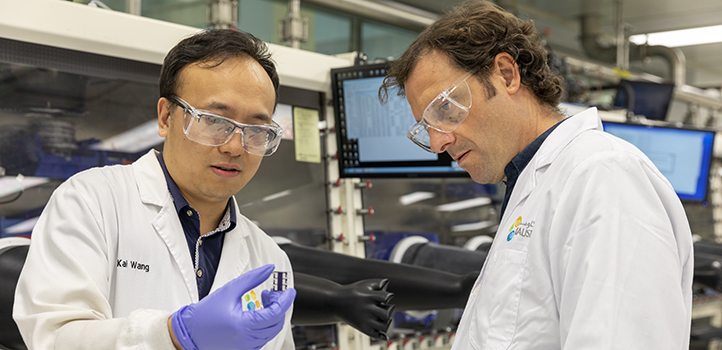Material Science and Engineering
Tiny tweaks for big wins in solar cells
Changes in composition are shown to affect light-harvesting layer crystallization and perovskite solar cell efficiency.

Solar cells that rely on perovskites to harvest sunlight are bound to gain in energy conversion efficiency thanks to an atomic-level understanding of the structure-property relationship of these photovoltaic materials. Researchers from the KAUST Solar Center monitored the impact of compositional changes on the structural organization and photovoltaic properties of perovskite thin films in situ1, 2.
Hybrid perovskites have emerged as key components in low-cost, high-efficiency solar cells because they are cheaper and easier to process than traditional silicon-based solar cell materials. In addition, they exhibit unique optoelectronic characteristics, including high light absorption and a defect tolerance that lead to solar cells with maximum power-conversion efficiencies of 24 to 28 percent when used alone or in tandem combination with silicon. They also outperform single-junction silicon solar cells.
KAUST materials scientists are using an in situ X-ray scattering technique to provide critical insights into the crystallization of the multicomponent systems toward high-performance perovskite solar cells.
© 2019 KAUST
Solar cell performance and stability depend on the morphology of the thin films, especially their ability to crystallize in the so-called photoactive α-phase. Perovskites containing lead tend to combine various halides, such as the anionic forms of bromine and iodine, with mixtures of methylammonium, formamidinium, cesium and other cations. These have led to record conversion efficiencies and thermal stabilities compared with their single-halide, single-cation analogs. However, these mixed-halide, mixed-cation perovskite films have been characterized only through ex-situ postdeposition techniques. This limits the understanding of the mechanisms that govern their growth from their sol-gel precursor to their solid state and stalls attempts to improve device performance and stability.
Now, Stefaan De Wolf, his postdoc Kai Wang and coworkers have investigated the impact of cations, halides and antisolvent dripping on mixed-halide, mixed-cation perovskite films. The team tracked the films’ structural evolution during the spin-coating deposition process using an in situ X-ray scattering technique. The X-ray technique probed the films at the atomic scale from their sol-gel precursor to the solid state and provided information about the formation of crystalline intermediates during the solidification. The researchers also incorporated the films into solar cells and evaluated the performance and stability of the resulting devices.

This sequence captures the fabrication process of a perovskite thin film from precursor solution to solid film via the spin-coating deposition process.
© 2019 KAUST
“Our study provides critical insights into the crystallization of the multicomponent systems toward high-performance perovskite solar cells,” Wang says. Changes in the compositions of the halide and cation dramatically affected the solidification of the perovskite precursors during spin coating and the subsequent formation of the desired α-phase upon antisolvent addition.
The period needed to generate high-quality films by antisolvent addition ended when the sol-gel structure collapsed to produce crystalline by-products depending on the precursor mixture. Consequently, tuning the halide-cation mixture could delay this collapse, widening the antisolvent dripping window from a few seconds to several minutes. As well, simultaneously incorporating cesium and rubidium cations in the perovskite synergistically stimulated the formation of the α-phase. The length of this window showed little effect on resulting solar cell performance as long as the antisolvent was added within this period.
These findings suggest new directions for the development of perovskite formulations that can further stabilize the sol-gel state and promote its conversion to the desirable perovskite phase. “This is critical in achieving better-performing, reproducible, cost-efficient and scalable manufacturing of perovskite solar cells,” Wang says.
The team is working on transferring this knowledge to other deposition technologies to progress toward market-ready perovskite solar cells.
References
-
Dang, H. X., Wang, K., Ghasemi, M., Tang, M.-C., De Bastiani, M., Aydin, E., Dauzon, E., Barrit, D., Peng, J., Smilgies, D.-M & De Wolf, S. Multi-cation synergy suppresses phase segregation in mixed-halide perovskites. Joule a 3, 1746-1764 (2019).| article
- Wang, K., Tang, M.-C., Dang, H.X., Munir, R., Barrit, D. De Bastiani, M., Aydin, E., Smilgies, D.-M.,De Wolf, S. & Amassian, A. Kinetic stabilization of the sol-gel state in perovskites enables facile processing of high-efficiency solar cells. Advanced Materials 31, 1808357 (2019).| article
You might also like

Applied Physics
A single additive enables long-life, high-voltage sodium batteries

Bioengineering
Smart patch detects allergies before symptoms strike

Applied Physics
Two-dimensional altermagnets could power waste heat recovery

Applied Physics
Interface engineering unlocks efficient, stable solar cells

Applied Physics
The right salt supercharges battery lifespan

Applied Physics
Light-powered ‘smart vision’ memories take a leap forward

Applied Physics
Natural polymer boosts solar cells

Material Science and Engineering




